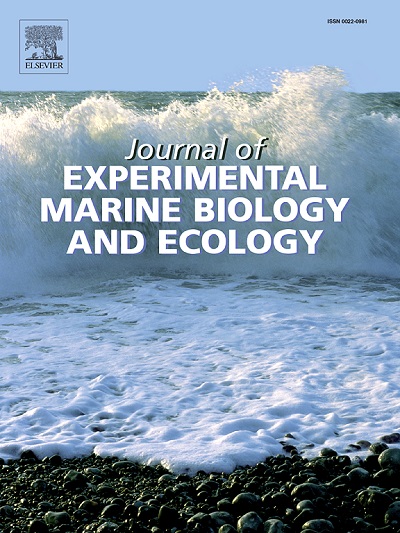Unravelling multifactor influences on photosymbiosis within a tropical anthozoan (Isactinia sp.)
IF 1.8
3区 生物学
Q3 ECOLOGY
Journal of Experimental Marine Biology and Ecology
Pub Date : 2025-01-01
DOI:10.1016/j.jembe.2024.152072
引用次数: 0
Abstract
The symbiotic relationship that photosymbiotic anthozoans share with Symbiodiniaceae is an important aspect of not only their health, but the success of the broader ecosystems in which they reside. This relationship is fragile however and is susceptible to perturbations to physiochemical factors within the environment. Using conditions ecologically relevant to the Great Barrier Reef, the aim of this study was to unravel the individual and combined impacts of temperature and salinity on the population density of Symbiodiniaceae within a small tropical sea anemone (Isactinia sp.) over time. A significant interaction between the three factors was identified. While salinity was shown to be the leading cause of symbiont loss within the first week, over the duration of the 21-day study, temperature ultimately emerged as the primary driver of bleaching. The impact on Symbiodiniaceae density varied however, with instances of the density more than doubling under mid-range conditions. Ultimately the results of this study contribute to our understanding of the complex and dynamic nature of photosymbiosis within tropical anthozoans. By thoroughly unravelling the intricacies of the anthozoan-Symbiodiniaceae we are better able to predict how such species may respond to changing environmental conditions into the future.
揭示热带珊瑚虫(Isactinia sp.)内光共生的多因素影响
光共生珊瑚虫与共生体科的共生关系不仅关系到它们的健康,而且关系到它们所处的更广泛的生态系统的成功。然而,这种关系是脆弱的,容易受到环境中物理化学因素的干扰。利用与大堡礁相关的生态条件,本研究的目的是揭示温度和盐度对小型热带海葵(Isactinia sp.)内共生菌科种群密度的个体和综合影响。这三个因素之间存在显著的相互作用。虽然在第一周内,盐度被证明是共生损失的主要原因,但在为期21天的研究期间,温度最终成为白化的主要驱动因素。然而,对共生菌科密度的影响各不相同,在中等条件下,密度增加了一倍以上。本研究的最终结果有助于我们理解热带珊瑚虫体内光共生的复杂性和动态性。通过彻底解开花青虫-共生体科的错综复杂,我们能够更好地预测这些物种如何对未来不断变化的环境条件做出反应。
本文章由计算机程序翻译,如有差异,请以英文原文为准。
求助全文
约1分钟内获得全文
求助全文
来源期刊
CiteScore
4.30
自引率
0.00%
发文量
98
审稿时长
14 weeks
期刊介绍:
The Journal of Experimental Marine Biology and Ecology provides a forum for experimental ecological research on marine organisms in relation to their environment. Topic areas include studies that focus on biochemistry, physiology, behavior, genetics, and ecological theory. The main emphasis of the Journal lies in hypothesis driven experimental work, both from the laboratory and the field. Natural experiments or descriptive studies that elucidate fundamental ecological processes are welcome. Submissions should have a broad ecological framework beyond the specific study organism or geographic region.
Short communications that highlight emerging issues and exciting discoveries within five printed pages will receive a rapid turnaround. Papers describing important new analytical, computational, experimental and theoretical techniques and methods are encouraged and will be highlighted as Methodological Advances. We welcome proposals for Review Papers synthesizing a specific field within marine ecology. Finally, the journal aims to publish Special Issues at regular intervals synthesizing a particular field of marine science. All printed papers undergo a peer review process before being accepted and will receive a first decision within three months.

 求助内容:
求助内容: 应助结果提醒方式:
应助结果提醒方式:


